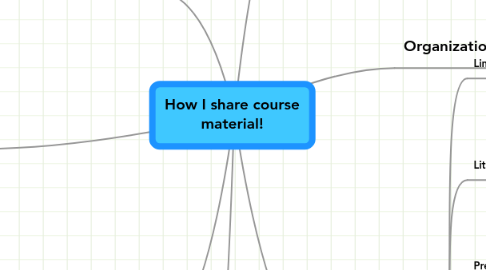
1. Educational goals
1.1. Introduction and exposure to Web 2.0 as life long learning tool
1.2. "You can do it too!" by using "free" tools
1.3. The world is changing! So are the resources in the course.
1.4. Exposure to sharing
1.5. Facilitate social constructivism
1.6. Facilitate building of student's professional networks
2. Use of LMS
2.1. Pro
2.1.1. Organization of course
2.1.2. Tasks
2.1.3. Messaging to students
2.1.4. Messaging between students
2.1.5. Grading
2.1.6. Use of RSS aggregator to pull all services together
2.2. Contra
2.2.1. Restricted to students
2.2.2. Small audience
2.2.3. No external input
2.2.4. Course material not available after graduation
2.2.5. Difficult to update several courses
3. Great examples
3.1. MIT Open Courseware
3.2. Wikiversity
3.3. OCW Consortium
3.4. OEDb Online Education Database
3.5. CCK08 Connectivism & Connective Knowledge
4. Projects
4.1. Replace copyrighted material
4.2. Build virtual, open courses on my website by aggregating all available open content
4.3. Build suggestions for learning paths out of the material.
5. What is in it for me?
5.1. Discovering new collegues
5.2. Building professional network
5.3. Exposure to peer review
5.3.1. Comments
5.3.2. Email through contact info
5.4. Filtering of web content
5.5. To be informed
5.6. Involve students in discovering in building of content
6. Services
6.1. Links
6.1.1. diigo.com (RSS)
6.1.1.1. Groups
6.1.1.2. Friends
6.1.1.3. Lists (Topic)
6.2. Literature
6.2.1. CiteULike.org (RSS)
6.2.1.1. Groups (Common Library)
6.2.1.2. Friends
6.2.1.3. Tags
6.3. Presentations
6.3.1. slideshare.net (RSS)
6.3.1.1. Groups
6.3.1.2. Friends
6.3.1.3. Tags
6.4. Mindmaps
6.4.1. mindmeister.com
6.4.1.1. Friends (share, collaborate)
6.5. News and short texts
6.5.1. info.ulrich-schrader.de (RSS)
6.5.1.1. Tags
6.5.2. Blogger.com (RSS)
6.5.2.1. Tags
6.6. Lectures
6.6.1. Podcasts
6.6.1.1. Feedburner (RSS) -> iTunes
6.6.1.2. Blogger.com (RSS)
6.6.1.2.1. Taqs
6.6.2. Screencasts
6.6.2.1. Blogger.com (RSS)
6.6.2.1.1. Tags
6.6.2.2. info.ulrich-schrader.de (RSS)
6.6.2.2.1. Tags
6.6.3. Open Moodle Courses
6.7. Documents
6.7.1. Wikispaces.com (RSS)
6.7.1.1. Groups
6.8. Thesis
6.8.1. Open Journals at Really-Nice-Research.de
7. Organization of content
7.1. Groups
7.1.1. Common collection of resources by a group around a common interest.
7.2. Friends
7.2.1. Individual collections done by others can be followed.
7.3. Lists
7.3.1. Individual collection of resources organized in lists mostly with common topic
7.4. Tags
7.4.1. Grouping of resources across users using public keywords (folksonomies)
